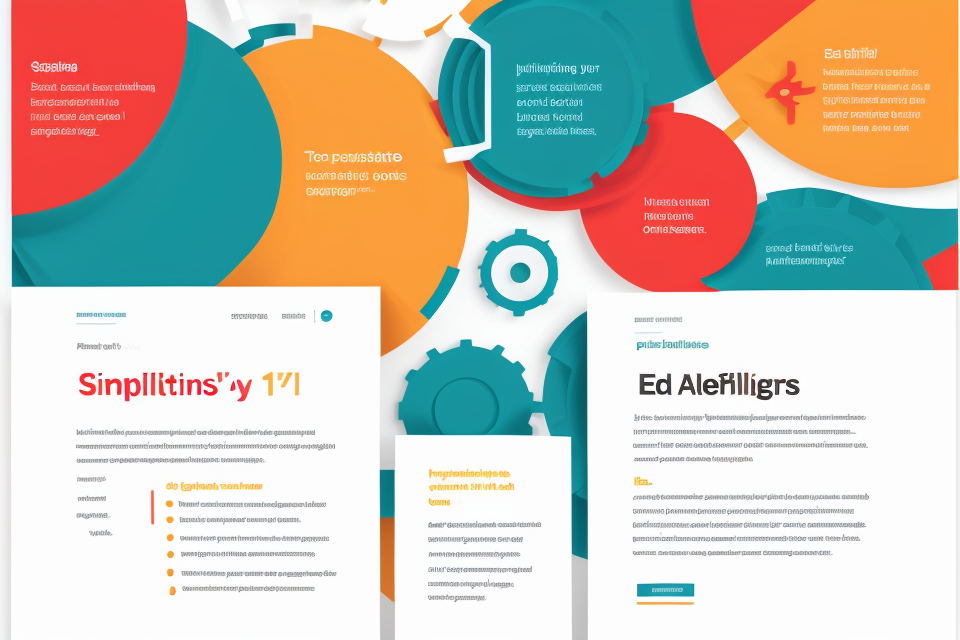
Optimizing software refers to the process of improving the performance, efficiency, and effectiveness of a software application. It involves identifying and addressing issues such as slow load times, memory leaks, and other bottlenecks that can negatively impact the user experience. In today’s fast-paced digital world, optimizing software is crucial for ensuring that applications run smoothly and efficiently, providing users with a seamless and enjoyable experience.
Effective software optimization requires a deep understanding of the software’s architecture, codebase, and user behavior. It involves using a range of tools and techniques, such as profiling, caching, and parallel processing, to improve the software’s performance and scalability.
In this article, we will explore the importance of optimizing software and provide practical tips and best practices for doing it effectively. Whether you are a developer, designer, or project manager, this article will provide you with valuable insights into how to optimize software for maximum performance and impact. So, let’s dive in and explore the world of software optimization!
Understanding Software Optimization
The Importance of Software Optimization
- Improving software performance
In today’s fast-paced digital world, users expect applications to load quickly and run smoothly. Optimizing software ensures that the application’s performance meets these expectations, leading to a better user experience.
- Enhancing user experience
Software optimization can have a direct impact on the user experience. By improving performance, reducing load times, and minimizing errors, software optimization helps to create a more positive user experience.
- Reducing hardware requirements
Optimizing software can also reduce the hardware requirements needed to run the application. This can lead to cost savings for users, as they may not need to invest in expensive hardware to run the software.
- Saving development time and costs
Finally, optimizing software can save development time and costs. By identifying and addressing performance issues early in the development process, developers can avoid costly delays and rework later on. Additionally, optimizing software can help reduce the overall development time, allowing developers to focus on creating new features and functionality.
Common Software Optimization Techniques
When it comes to software optimization, there are several techniques that can be employed to improve the performance and efficiency of a software application. In this section, we will discuss some of the most common software optimization techniques that are used by developers.
Code Refactoring
Code refactoring is the process of restructuring existing code to improve its readability, maintainability, and efficiency. This technique involves identifying and removing unnecessary code, simplifying complex code structures, and consolidating similar code blocks. By refactoring code, developers can improve the overall quality of the codebase, reduce the risk of errors, and improve the performance of the software application.
Caching
Caching is a technique that involves storing frequently accessed data in memory or on disk to reduce the amount of time it takes to retrieve that data. By caching data, developers can reduce the load on the application’s database and improve the overall performance of the software application.
Minification
Minification is the process of removing unnecessary characters from code to reduce its size and improve its performance. This technique involves removing whitespace, comments, and other unnecessary characters from code, which can significantly reduce the size of the codebase and improve the speed at which the application runs.
Image Optimization
Image optimization involves reducing the size of images and other media files used in a software application to improve its performance. This technique involves compressing images, reducing their resolution, and optimizing them for web use. By optimizing images, developers can reduce the amount of data that needs to be transferred over the internet, which can significantly improve the performance of the software application.
Database Optimization
Database optimization involves improving the performance of a software application’s database by optimizing its structure, indexing, and queries. This technique involves identifying and removing unnecessary database tables, optimizing database queries to reduce their complexity and improve their efficiency, and ensuring that database indexes are properly configured. By optimizing the database, developers can improve the overall performance of the software application and reduce the risk of errors.
Approaches to Software Optimization
Proactive Optimization
Conducting Code Reviews
Code reviews are an essential aspect of proactive optimization. They involve a thorough examination of the codebase by developers to identify and eliminate errors, inefficiencies, and potential security vulnerabilities. By reviewing code regularly, developers can ensure that their code adheres to established best practices and design patterns, resulting in a more efficient and maintainable software system.
Following Best Practices and Design Patterns
Adhering to best practices and design patterns is another crucial aspect of proactive optimization. Best practices are a set of guidelines that developers follow to ensure that their code is efficient, maintainable, and secure. Design patterns, on the other hand, are reusable solutions to common software design problems. By following these guidelines, developers can create code that is easier to understand, modify, and maintain, ultimately resulting in a more efficient software system.
Utilizing Profiling Tools
Profiling tools are software applications that help developers identify performance bottlenecks in their code. These tools analyze the code and provide insights into which functions are taking the most time to execute, which can help developers optimize their code for better performance. By using profiling tools, developers can identify and eliminate inefficiencies in their code, resulting in a more efficient software system.
Implementing Scalable Architecture
Scalable architecture is an essential aspect of proactive optimization. It involves designing software systems that can handle increasing amounts of data and traffic without compromising performance. By implementing scalable architecture, developers can ensure that their software systems can grow and adapt to changing requirements, resulting in a more efficient and flexible software system.
Overall, proactive optimization is essential for creating software systems that are efficient, maintainable, and scalable. By conducting code reviews, following best practices and design patterns, utilizing profiling tools, and implementing scalable architecture, developers can ensure that their software systems are optimized for better performance and scalability.
Reactive Optimization
Monitoring Application Performance
Monitoring application performance is the first step in reactive optimization. It involves collecting data on various metrics such as response time, throughput, and resource utilization. This data can be collected using tools such as profilers, log analyzers, and performance monitoring systems.
Identifying Bottlenecks
Once the performance data has been collected, the next step is to identify bottlenecks in the application. Bottlenecks can occur at various levels, such as the CPU, memory, network, or disk I/O. By identifying these bottlenecks, developers can focus their optimization efforts on the areas that need the most attention.
Implementing Caching and Other Performance-Enhancing Measures
Once the bottlenecks have been identified, developers can implement caching and other performance-enhancing measures. Caching is a technique that involves storing frequently accessed data in memory to reduce the number of disk I/O operations. Other performance-enhancing measures include optimizing database queries, reducing network latency, and reducing the number of system calls.
Debugging and Resolving Issues
The final step in reactive optimization is debugging and resolving issues. This involves analyzing the performance data and the application code to identify the root cause of performance problems. Once the root cause has been identified, developers can implement fixes such as refactoring code, optimizing algorithms, and improving resource utilization.
In summary, reactive optimization involves monitoring application performance, identifying bottlenecks, implementing caching and other performance-enhancing measures, and debugging and resolving issues. By following these steps, developers can optimize their software and improve its performance.
Best Practices for Software Optimization
Writing Efficient Code
Effective software optimization begins with writing efficient code. Efficient code is not only easier to maintain and debug, but it also leads to improved performance and better resource utilization. In this section, we will discuss some best practices for writing efficient code.
- Minimizing I/O operations: Input/Output (I/O) operations are among the most time-consuming operations in any software application. To improve performance, it is essential to minimize I/O operations as much as possible. This can be achieved by optimizing the design of the application to reduce the number of I/O operations required, caching frequently accessed data, and using efficient algorithms to read and write data.
- Avoiding unnecessary computations: Unnecessary computations can significantly impact the performance of an application. To avoid this, it is essential to ensure that each computation is necessary and performs the intended task. This can be achieved by carefully designing algorithms, eliminating redundant computations, and optimizing the order of computations to minimize the number of steps required.
- Utilizing efficient data structures: The choice of data structures can significantly impact the performance of an application. To optimize performance, it is essential to choose data structures that are appropriate for the task at hand. For example, using an array instead of a linked list can improve performance in many cases.
- Implementing concurrency and parallelism when appropriate: Concurrency and parallelism can improve the performance of an application by allowing multiple tasks to be executed simultaneously. However, it is essential to implement concurrency and parallelism correctly to avoid performance issues such as race conditions and deadlocks. This can be achieved by using thread-safe data structures, synchronizing access to shared resources, and carefully designing algorithms to take advantage of concurrency and parallelism.
Utilizing Performance Monitoring Tools
Performance monitoring tools are essential for optimizing software effectively. These tools provide insights into the behavior of an application and help identify performance bottlenecks. Here are some ways performance monitoring tools can be utilized:
- Identifying performance bottlenecks: Performance monitoring tools can help identify the specific areas of an application that are causing performance issues. This information can then be used to optimize the code and improve the overall performance of the application.
- Profiling application behavior: Performance monitoring tools can provide detailed information about how an application is using system resources, such as CPU, memory, and disk I/O. This information can be used to identify areas of the application that are using resources inefficiently and optimize them for better performance.
- Analyzing resource usage: Performance monitoring tools can help identify which resources are being used by the application and how they are being used. This information can be used to optimize the application’s resource usage and improve its overall performance.
- Benchmarking and comparing performance: Performance monitoring tools can be used to benchmark the performance of an application and compare it to other applications or previous versions of the same application. This information can be used to identify areas for improvement and optimize the application’s performance.
Overall, utilizing performance monitoring tools is an essential part of software optimization. These tools provide valuable insights into the behavior of an application and help identify areas for improvement. By using performance monitoring tools effectively, developers can optimize their applications for better performance and a better user experience.
Keeping Up with Technological Advancements
- Staying informed about new technologies and methodologies
To keep up with technological advancements, it is essential to stay informed about new technologies and methodologies that can be applied to your software development process. This includes staying up-to-date with the latest programming languages, frameworks, and libraries.
- Regularly updating software and libraries
It is important to regularly update your software and libraries to ensure that you are using the most recent versions. These updates often include bug fixes, security patches, and performance improvements that can benefit your software.
- Implementing automated testing and continuous integration
Automated testing and continuous integration are important practices to implement in your software development process. Automated testing helps to ensure that your software is functioning correctly and catches bugs before they become major issues. Continuous integration helps to catch issues early in the development process, making it easier and less time-consuming to fix them.
- Embracing cloud-based solutions for scalability and performance
Cloud-based solutions can offer significant benefits for software optimization, including scalability and performance. By using cloud-based solutions, you can easily scale your software to meet increasing demand and improve performance by leveraging the resources of the cloud provider. This can help to reduce costs and improve the overall user experience of your software.
Continuous Improvement
- Regularly reviewing and refactoring code
- Conducting performance audits
- Incorporating user feedback
- Addressing performance issues proactively
Regularly Reviewing and Refactoring Code
Code reviews are a crucial aspect of software development, as they allow developers to identify and fix issues before they become major problems. By regularly reviewing code, developers can ensure that their code is maintainable, efficient, and easy to understand. This process should involve analyzing the code for potential improvements, such as refactoring and simplifying complex logic. Additionally, developers should look for opportunities to eliminate redundancy and optimize the code for better performance.
Conducting Performance Audits
Performance audits are an essential part of software optimization, as they help identify areas of the code that can be improved to enhance the overall performance of the application. Performance audits involve analyzing the code to identify bottlenecks, measuring the time it takes for the application to execute specific tasks, and identifying areas of the code that consume the most resources. Once identified, developers can implement changes to improve the performance of the application, such as optimizing database queries or reducing the number of network requests.
Incorporating User Feedback
User feedback is an invaluable resource for software optimization, as it provides insight into the areas of the application that users find challenging or frustrating. By incorporating user feedback, developers can identify areas of the application that require improvement and prioritize optimizations accordingly. Additionally, user feedback can help developers understand how users interact with the application, allowing them to optimize the user experience and improve overall satisfaction.
Addressing Performance Issues Proactively
Proactive performance optimization is critical to ensuring that the application performs optimally under various conditions. This involves monitoring the application’s performance, identifying potential bottlenecks, and implementing changes to address them before they become significant issues. Developers should use performance monitoring tools to track metrics such as response time, CPU usage, and memory consumption to identify areas of the application that require optimization. Additionally, developers should prioritize optimizations based on the potential impact on the user experience and overall performance of the application.
FAQs
1. What does it mean to optimize software?
Optimizing software refers to the process of improving its performance, efficiency, and effectiveness. This involves identifying and eliminating bottlenecks, reducing memory usage, and minimizing the execution time of algorithms. The goal of software optimization is to make the software run faster, consume fewer resources, and deliver better results.
2. Why is software optimization important?
Software optimization is important because it helps to improve the overall performance of software applications. When software is optimized, it can handle more users, process data faster, and deliver better results. This leads to improved user experience, increased productivity, and reduced hardware requirements. In addition, software optimization can also help to reduce energy consumption and lower the carbon footprint of software applications.
3. What are the benefits of optimizing software?
The benefits of optimizing software include improved performance, reduced resource usage, and enhanced user experience. Optimized software can handle more users, process data faster, and deliver better results. This leads to increased productivity, reduced hardware requirements, and lower energy consumption. In addition, optimized software can also help to reduce the carbon footprint of software applications and make them more environmentally friendly.
4. How can I optimize my software?
There are several techniques for optimizing software, including profiling, caching, minimizing I/O operations, and using efficient algorithms. Profiling involves analyzing the performance of software to identify bottlenecks and areas for improvement. Caching involves storing frequently accessed data in memory to reduce the number of I/O operations. Minimizing I/O operations involves reducing the number of disk reads and writes to improve performance. Efficient algorithms can also help to reduce the execution time of software by minimizing the number of computations required.
5. Are there any tools available to help with software optimization?
Yes, there are several tools available to help with software optimization. These include profiling tools, such as gprof and valgrind, which can help to identify performance bottlenecks. There are also caching tools, such as the Linux kernel’s page cache, which can help to improve performance by storing frequently accessed data in memory. In addition, there are also a variety of compilers and libraries, such as the GNU Compiler Collection (GCC) and the Intel Integrated Performance Primitives (IPP) library, which can help to optimize software by providing efficient implementations of common algorithms.


